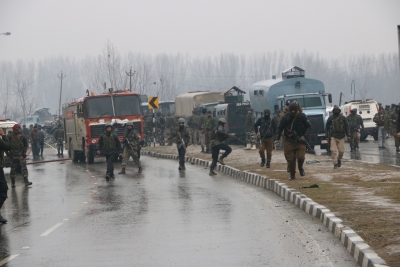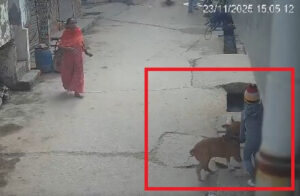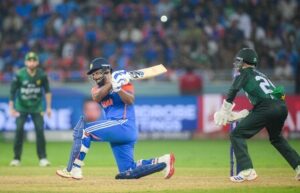Course correction in Kashmir

Site of the Pulwama Terror Attack (File Photo/IANS)
Site of the Pulwama Terror Attack (File Photo/IANS)
By D.C. Pathak
The horrendous killing of more than 40 CRPF jawans in a frontal attack on its convoy on February 14 at Pulwama, not too far from Srinagar, by a locally recruited suicide bomber of Jaishe Mohammad (JeM) comes as a stark reminder of how the Pakistan Army remains undeterred in its pursuit of a ‘proxy war’ against India – using Islamic extremists as its instrument.
Since the Lashkar-e-Toiba (LeT)of Maulana Hafiz Sayeed had come too much into limelight in the context of cross-border terrorism, the Pak ISI had for some time been focusing on Jaishe Mohammad(JeM) the notorious radical outfit run by Pak -based Maulana Masood Azhar -that had the capability of raising ‘fidayeen’ in the name of ‘jehad’.
The attack on the CRPF convoy was made with a ‘car bomb’ laden with more than 60 kgs of RDX mix-indicating the depth of planning and resource mobilisation carried out by the enemy right under the nose of the Kashmir government. Intelligence from Central agencies pointed to the possibility of a car bomb attack on security forces which was the sign of a clear escalation after organised stone pelting and grenade throwing had proved to be tactics of diminishing returns for Pakistan’s Inter Services Intelligence (ISI).
The PDP-BJP coalition might have been envisaged as a political strategy meant to demonstrate progress in the return of democratic governance in the state but it did not – for reasons too well known – make any dent on the Pakistan Army’s resolve to compel India to resume talks under the pressure of terrorist violence.
The appointment of a politician as the Governor was meant to give a message that return to normalcy of a democratic rule could sit well with the ongoing requirement of Army-led operations against cross border terrorism but in the bargain the deepening threat of Pakistan’s covert offensive somewhere ran into ambiguity of interpretation. The political leaders of the Valley – unsurprisingly- refused to condemn terrorists and shamelessly pegged the line that India must seek out Pakistan for peace talks regardless of the latter’s terrorist offensive.
Domestic politics blinded the critics of the government against the logic of a Pakistan policy that called upon the hostile neighbour to cease infiltrating terrorists from across the LOC to make way for resumption of dialogue.
The car bomb attack on CRPF convoy would no doubt lead to a post-event examination of the logistic management of the paramilitary forces deployed in the terror-infected state on one hand and, the functioning of the Unified High Command in J& K in key areas like follow-up on the specific alerts from the Centre and the operational needs of the forces working in conjunction with the Army.
There was intelligence about the imminence of a car bomb attack on security forces and therefore to prevent a chain of 70-80 vehicles -transporting over 2,500 soldiers through a terror-affected territory – from becoming a soft target measures beyond the routine road clearing and sanitising exercise were required.
Stopping civilian traffic for a while as a one time step could have prevented a vehicle from getting close to the moving convoy. Was the option of air -lift- a standard practice with the Army- considered at all? If not was it linked to the availability of resources for the para- military forces?
Rising above the details of the terror attack at Pulwama there is need for a course correction in Kashmir on three distinct points. First, the presumption that the problem of dealing with terrorism in the state concerned only the Army must give way to an acknowledgement that J&K – the target of attack from Pakistan – was a virtual war zone where the entire hierarchy of governance- from Governor to the Deputy Commissioner in charge of the district- had to be attuned to the nature and content of the ‘proxy war’ facing India.
The state administration had to have a share of responsibility in acting on the Intelligence made available and in furthering the work of identifying and locating the Pak agents hibernating in its various wings and outside.
A major problem in Kashmir is the inadequacy of ‘Intelligence from below’ even as the flow of information from the Central agencies was substantial and actionable. The state could do with an experienced civilian of Intelligence background as the Head of the state to make up for the deficiencies of local response.
Secondly, the policy in Kashmir must aim at neutralising the Pak-sponsored terrorist violence, putting the civilian population on a grid of understanding through empathetic interactions of Deputy Commissioner and District SP with the people on a regular basis for grievance redressal and pressing forth with development projects on the ground.
Moves to encourage democratic processes are welcome but security assessments should be kept free of wishful thinking and political expediency. Pakistan has not wavered from the plan it had set in the early Nineties for replicating the success of Afghan Jehad in Kashmir by pumping in Mujahideen in the valley.
Pak agencies have been following a rolling plan of destabilising Kashmir since then- they used their agents to recruit stone pelters for creating disorder, instigated grenade lobbing on security personnel and sensing the opportunity of recruiting militants locally, started sending out trainers to enlist indoctrinated youngsters in their teens for carrying out attacks. Pulwama offensive is a striking upshot of this new plan of ISI- Adil Ahmad Dar the suicide bomber is said to have been trained by an IED expert from Pakistan.
JeM is close to Al Qaeda- Taliban combine- the first set of Mujahideen called Harkat ul Ansar that was sent in by Pak ISI way back in 1993 to launch Jehad in Kashmir had the protagonists of Taliban and Jaish as its members.
Thirdly, Pak agencies have got into the day to day life of Kashmiris thanks to the existence of a ‘fifth column’ in the state operating within and outside of the administration and the political umbrella. Pak army has withstood the denunciation by President Donald Trump of its role in providing safe havens to terrorists and even gone on to rebuff the US by declaring that Pakistan committed a grave mistake in joining the ‘American war on terror’.
Once the artificial distinction made by the West between ‘good terrorists’ and ‘bad terrorists’ -which gave advantage to Pakistan over India -was withdrawn by the US President, Pak army has lost no time in openly supporting radicals ,switching over to war like attacks by fedayeen and taking to the radical methodology of using ‘car bombs’ against security forces. Also,Pakistan seems to be succeeding in securing a hold in Afghanistan through its bonhomie with Taliban and this clearly has the potential for strengthening cross border terror in Kashmir.
India’s policy package for Kashmir suggests itself: go all out to eliminate terrorists in the state through Intelligence -based operations, identify the enemy agents within- hibernating in administration or the political arena -for stringent action and reach out to the youth through the district administration to open up economic opportunities for them. Our Army should now switch over to ‘offence is the best defence’ on LOC- to deal with infiltration and violations of ceasefire.
The withdrawal of MFN status is the right first step to announce to the world that India now means business as far as the handling of a rogue neighbour was concerned. Pakistan can not take on India in a conventional war and also knows that it has lost the earlier advantage it had of raising the ‘nuclear flash’ argument to get international attention in a situation of conflict with India.
(The writer is a former Director Intelligence Bureau)





